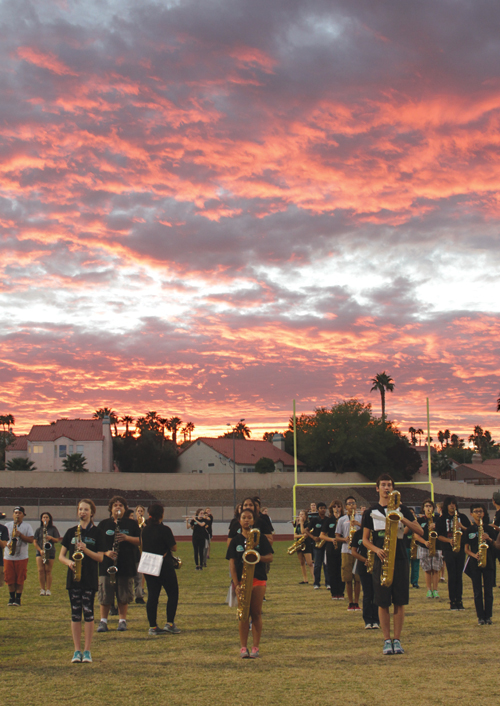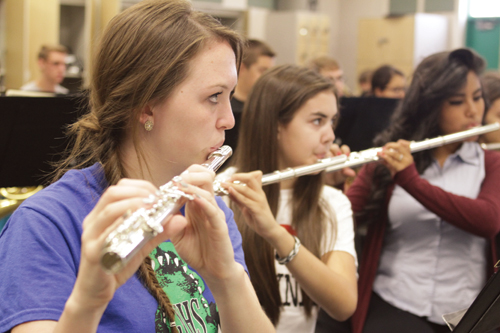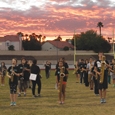
The end of the school year, which I define as after the spring concert, is a crucial time for getting a strong start to the following year. I prefer to have the spring concert two to three weeks before school ends. Having it too early means that students really lose focus by the end of the year, but scheduling it later than this time frame eliminates the opportunity to take care of all the necessary end-of-year procedures and preparations for the following year.
Using Rehearsal Time Wisely
After the final concert, we spend much of our time sightreading music. The end of the year is an excellent time to read through standard works that all students should get a chance to play at some point. In addition, there is often music in the library that I am unfamiliar with but would like to gain further knowledge about. This is usually concert band music. Although we try to get the marching band music out to students before they leave for summer break, I avoid spending the year’s final rehearsals working on that marching music exclusively because graduating seniors have little interest in it. Having marching music rehearsals with uninterested seniors does not help to promote excitement in the underclassmen for the upcoming year. A better choice is concert band music that may have a great feature for a graduating senior, perhaps giving them one more chance to be recognized.
After the spring concert, we also begin to focus on final exam preparation. The final exam is different every year. I like to choose tests that are pertinent to the ensemble that year or that covers something the ensemble will need work on for the following year. There have been years where the focus of the final has been scales. Some years, it has been sightreading. Other years I have had exams on the following year’s marching band warmups. The subject determines when I give the exam. If it is a written final I can give it on exam day, but for a playing final we start it a bit earlier.
Building Next Year’s Marching Band
There are many elements to a successful marching show: securing drill writers and design teams, choosing music that fits the program, arranging planning and design meetings, hiring staff, choosing pep band music, registering for shows, and completing work on camps and fall schedules. Before walking out the door for the summer, it is important to have a clear idea and organization of all these.
Before students leave for summer, ideally, they should have their new marching music to practice at home, access to all dates and times of summer rehearsals and camps, an accurate fall schedule, an equipment list needed for fall, an estimated fee schedule, and the ability to check out instruments. Visits to the feeder middle schools are crucial to make sure incoming freshmen understand the schedule and details for the upcoming season. Usually those last few weeks of school are a great opportunity to travel to the middle school and answer student questions. It is also a good idea to make sure the administration, registrar, and office staff have your summer letters and information for any student who enrolls during summer.
Sometimes we know we will have a shortage of one instrument for the following year. Paying attention to this early gives us an opportunity to consider who might be good candidates to switch instruments. I often start this before our spring concert, getting students to try instruments and then working with them to see whether this is a switch they want to make.

Training Solid Leaders
The end of the year is important for developing student leaders for the following year. As music teachers, we have a direct influence on those students returning to the program. A math teacher doesn’t always have control over how another math teacher is preparing those students for their class the next year. Music teachers should take advantage of this opportunity by starting early and making it a priority.
In April we start discussing leadership with the students. We schedule meetings for potential student leaders every two weeks in late spring. The first meeting gets students in the door. We explain student leader expectations, list the different positions available, and discuss basic leadership concepts. In that initial meeting we also walk them through the audition and application processes. This includes an interview, essay, service and fun project, and letters of recommendation, as well as an audition for drum majors.
We meet again in a few weeks to discuss more leadership concepts and to explore some activities designed to get students thinking as leaders and working collaboritively. These meetings continue through April and May, and include getting the current student leaders, especially the ones who are graduating, to mentor leadership candidates.
The sightreading we do after the spring concert provides an excellent opportunity to put students in leadership positions and see how they handle it, as well as how other students react to their direction. I pull the sightreading pieces out of the library and assign them to potential student leaders. Over a two-to-three day period, students interested in becoming section leaders are given time to run sectionals on their assigned parts while I observe them. Following these days are two or three rehearsals in which students auditioning for drum major will conduct the band. Potential drum majors each get a turn to conduct for 15 minutes. Students are always supportive of each other during this process. They mentor each other, work hard to play their best, respond well to their instruction, and take a genuine interest in being part of the process. It keeps students interested and motivated in those final weeks after the spring concert.
Another important task for leadership candidates is helping with spring banquet preparation. We give them such responsibilities as helping with decorations, handing out awards, assembling slide shows, and collecting tickets at the door.
The last week of school ends with the remainder of the audition and interview process. Some people announce their leadership earlier in the year, but I like to wait until the last few days of school so I can give students as many opportunities as possible to prove themselves and let me see them in action. This helps with motivation through the end of the year, as leadership candidates know we are still watching.
Managing Inventory
Our inventory is assigned to students and returned through barcodes on our web-based system. The uniforms are the first bit of equipment that students turn in. The last time we use the uniforms is at a spring parade, held in mid to late April, so at the beginning of May we begin checking in uniforms and making sure they are cleaned. Returning students’ uniforms are kept together in a labeled garment bag. Assuming their size does not change, it is an easy checkout in the fall.
Collecting music, method books, warmups, and folders can be a daunting task. To alleviate this, method books and folders are barcoded so they are easily accounted for when they are turned in. To streamline the process, I assign section leaders to collect every part from their sections, making note of who has not turned in music. It makes students aware that people are paying attention that all the parts are there. If a student does not have the music that day, the section leader gets a note from me and places it on that section’s parts with the names of students who still need to turn in parts. Students who never turn in the music are fined.
When the section leader has collected all the music and organized it in part order, he brings the section parts to an assigned section, which collects all the band parts and places everything in score order. The trumpet section might be in charge of assembling one piece in score order, and the flutes might be assigned another. Once students have made sure all the parts are there, they bring it up, I add the score to the folder, then it gets filed. Pieces that are missing parts are set aside until the missing parts are returned. The process takes about 20 minutes and ensures everything is organized and packed away with little to no work by the teacher.
The last three days of school are spent on instrument check-in. We check the instruments in, inspect them to make sure they are still functioning, then send them out to be cleaned. When they come back in early summer, we schedule several days for students to stop by and check them out again.
The band room is not air conditioned in summer, and it gets extremely hot, so temperamental wooden wind instruments get stored in a part of the building that is air conditioned. There are only a few such instruments, so it is easy to find the space in a small closet somewhere.
Percussion is a separate class, which makes inventory and basic maintenance easy. During the last few days of class, we print off the inventory list, and students pull everything out of every cabinet and storage closet and place it in the middle of the room. Then we separate it by like instruments and assign students to instrument groups.
One group of students is assigned the instruments with drumheads. We detune our percussion equipment for the summer. We don’t take the heads off completely but just take the pressure off a bit so we can store them away. Temperature changes make things stretch and contract, so it is easier to detune the drums to save wear and tear on the heads, especially extremely tight ones like snares. For timpani, I won’t detune them, but I make sure the pedals are down all the way so the drums are at the lowest pitch.
A second group of students restrings all the mallet instruments that need it, and another group of students is assigned to dust everything and find cases to store things in. Before anything gets put away, we check it off the master inventory list and report any damaged or missing items. Additionally we take an inventory of mallets and new drum heads to make a list of what should be purchased before the start of school or camp.
We check in lockers on the last day. I bring in a bunch of cleaning/disinfecting wipes, students wipe everything down, then we check lockers, and the last thing students do is turn in their lock. In the process of turning in their lock, students check on the computer with us to make sure all inventory is in and that their accounts and fees are accurate. This is the last communication with students regarding their accounts prior to closing out the inventory and accounts and rolling things over for the following year.
There is much to do between the spring concert and the last day of school, but the hard work in instruction, fall preparation, and organization during the last weeks of school always pays dividends in fall.






